![]()
Sat, Nov 19, 2011 | Reuters
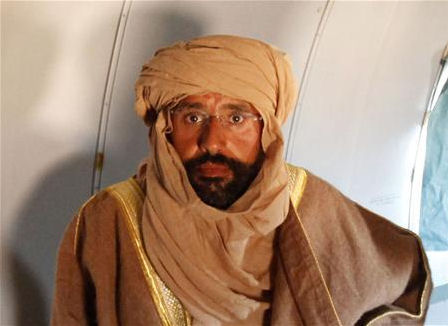
Saif al-Islam Gaddafi is seen sitting in a plane in Zintan November 19, 2011. (REUTERS/Ismail Zitouny)
Saif al-Islam captured in Libya’s southern desert: Bargaining chip in Libyan power struggle
On Saturday, Saif al-Islam Qaddafi told Reuters News Agency that he was feeling well after his earlier arrest around 70 km of Obari in the south of Libya.
A reporter of the news agency spoke to him in the plane which took him from Obari to the mountain town of Zintan. 39-year-old Saif al-Islam said that the injuries to his right hand were due to a NATO air strike on his convoy a month ago, October 19, when fleeing Bani Walid, one of the last bastions of the Qaddafi regime. Asked if he was feeling all right, Qaddafi said simply: “Yes.”
In short the events that led to Saif al-Islam’s capture, who had vowed to die fighting, but was taken without a struggle.
“At the beginning he was very scared. He thought we would kill him,” Ahmed Ammar, one of his captors, told a reporter from Reuters.
Ammar said that his unit of 15 men in three vehicles, acting on a tip-off about a possible high-profile fugitive, had intercepted two cars in a road ambush carrying Gaddafi accompanied by four others in the desert about 70 km (40 miles) from the small oil town of Obari at about 1:30 a.m. (2330 GMT on Friday). The mini convoy of two vehicles was apparently en route to the border with neighbouring Niger. In the cars were weapons and several thousand dollars.
The Zintan fighters fired in the air and forced the cars to stop, they asked the identity of the passengers. Saif al-Islam replied that he was “Abdelsalam” — a name that means “servant of peace” said the fighters but was almost immediately identified as Saif al-Islam Qaddafi and seized him.
The fighters said they put him at ease and he accepted he would be taken to Zintan, a town south of Tripoli that was a stronghold of anti-Gaddafi rebels.
Saif al-Islam appeared relatively at ease and was not handcuffed as he sat on a bench at the rear of the plane.
Wearing traditional robes with a scarf pulled over his face, Saif al-Islam had a heavy black beard and wore his rimless spectacles.
According to a fighter from an anti-Qaddafi unit, the Khaled bin al-Waleed Brigade, the arrest was the result of a tip from a local guide, Yousif Salih al-Mahdi. He was approached by Saif al-Islam’s entourage to smuggle him to Niger. However, the guide risked his live and told the new rulers about the whereabouts of the son of the slaugthered dictator. After that the ambush was organised.
“They couldn’t get away because we had a good plan,” Wisam Dughaly added, saying Saif al-Islam had been using a 4×4 vehicle.
Zintan could now use Saif al-Islam as a bargaining chip in the contest between rival groups for power in the new Libya. Fighters from Zintan made the decisive push on to Tripoli which ended Muammar Qaddafi’s rule.
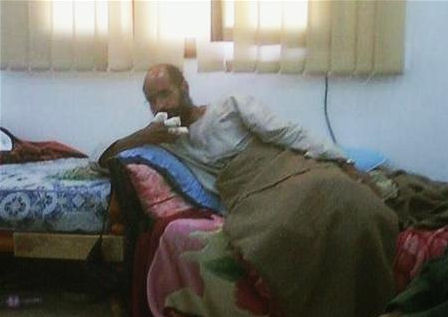
Saif al-Islam, son of the late former Libyan leader Muammar Gaddafi, sits after his capture, with his fingers wrapped in bandages and his legs covered with a blanket, at an undisclosed location, in this photograph aired on Free Libya TV on November 19, 2011. (REUTERS/Libya Free TV via Reuters TV)
DebkaFile’s intelligence sources reports:
Sat, Nov 19, 2011 | Debka.com
The announcement of the capture of Muammar Qaddafi’s son Saif al Islam, 39, outside Obari near the southern desert town of Sabha was initially celebrated as the last chapter of the ex-ruler’s family role in the fight for control of Libya — but not for long. Although justice minister claimed his arrest, it quickly turned out that Qaddafi’s son was in the hands of one of Libya’s most important militias, the Zintan Brigades, who refused to hand him over until a government is formed.
He was flown to their mountain stronghold in the Nafusa Mountains 136 kilometers southwest of Tripoli.
This Berber militia is not likely to let go of its valuable bargaining chip in a hurry. It enables its leaders to throw a wrench into the plans of Prime Minister Abdurrahim El-Keib to present his cabinet lineup Sunday for the National Transitional Council-NTC to confirm Tuesday. Nov. 22.
El-Keib was working on the list with NTC head Mustafa Abdul Jalil and the Tripoli commander Abdel Hakim Belhadj (ex-al Qaeda.)
However, Friday, Nov. 18, twenty-four hours before Saif al-Islam’s capture was announced, Zintan militia chief Abdullah Naker and the Misurata chief Abdulrahman Souweli formed a pact to overturn any new government which does not assign them the positions of defense minister and head of the army.
The Zintan commander Naker showed the press a video of his militiamen firing Grad missiles and driving T-72 tanks to show them he meant business.
Both militia chiefs were also highly critical of Qatar’s deep involvement in Libya’s internal affairs.“We are really grateful to Qatar for what they did for the Libyan people,” Naker said. But “the brand of Islam favored by Belhadj” is unsuited to Libya’s “moderate” religion, he said and stressed that Qatar “has no right to interfere in our affairs. We will not accept domination by Qatar or by anyone else.”
Interim government leaders in Tripoli and Benghazi dismissed the two militia leaders’ statements as unimportant and their threat to derail the next government as “not serious.”
But then, the Zintan militia’s capture of Qaddafi’s son turned the situation on its head.
The militia’s field commander Bashir Thaelba made it clear that Saif al Islam must have a fair trial but he would not be surrendered until his militia’s terms were met.
The International Criminal Court, which has a warrant out for Sair al Islam’s arrest, is sending its prosecutor to Tripoli Monday to determine how and where Qaddafi’s son will stand trial. He should not expect quick answers in the current power play among Libya’s militias over the wanted man’s head.
DEBKAfile’s intelligence sources point out that whereas Col. Qaddafi [and his son Muatassim Qaddafi] was captured near Sirte and killed on the turf of the Misurata militia, his son [Saif al-Islam] has fallen in the hands of another of Libya’s key militias, Zintan. Both Misurata and Zintan oppose the NTC heads and are especially unhappy about the Belhadj fundamentalists, former associates of al Qaeda lording it in Tripoli.
This sequence looks like part of the same pattern whereby certain Western forces hope to put obstacles in the path of Mustafa Jalil and his moves to let Belhadj gain control of the capital, especially since the strings of both appear to be pulled by the Emir of Qatar. The power struggle afoot will not just determine the nature of Libya’s government but also who controls its oil resources.



 RSS
RSS

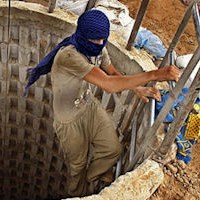
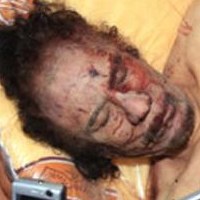
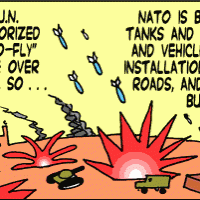

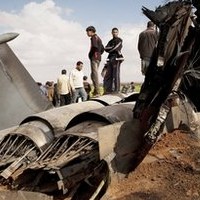




Saif al-Islam captured in Libya’s southern desert: Bargaining chip in Libyan power struggle | Middle http://t.co/Ygv3IiZA
"@CrethiPlethi: Saif al-Islam captured in Libya’s southern desert: Bargaining chip in Libyan power struggle | Middle http://t.co/M9IAya5f"
Saif al-Islam captured in Libya’s southern desert: Bargaining chip in Libyan power struggle | Middle http://t.co/Ygv3IiZA